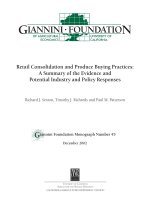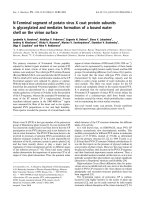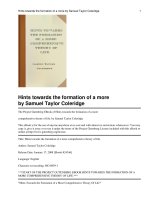Sea piracy and the formation of a regional response constructing asean maritime security from the strait of malacca anti piracy cooperation
Bạn đang xem bản rút gọn của tài liệu. Xem và tải ngay bản đầy đủ của tài liệu tại đây (1.19 MB, 129 trang )
SEA PIRACY AND THE FORMATION OF A REGIONAL
RESPONSE: CONSTRUCTING ASEAN MARITIME
SECURITY FROM THE STRAIT OF MALACCA
ANTI-PIRACY COOPERATION
MARCEL BANDUR
(B.A. (Hons.) International Relations, University of Durham)
THESIS SUBMITTED FOR
THE DEGREE OF MASTER OF SOCIAL SCIENCES
DEPARTMENT OF POLITICAL SCIENCE
NATIONAL UNIVERSITY OF SINGAPORE
2014
ii
DECLARATION
I hereby declare that this thesis is my original work and it has been written by me in
its entirety. I have duly acknowledged all the sources of information which have been
used in the thesis.
This thesis has also not been submitted for any degree in any university previously.
Marcel Bandur
18 August 2014
iii
iv
ACKNOWLEDGEMENTS
Working on this thesis has been an exceptionally enriching and humbling experience. I
would like to express my most sincere gratitude to my supervisor, Dr. Ian Ja Chong, for his
indispensable guidance throughout the research. His insightful comments, tireless support
and warm encouragement have always been motivating. I also owe a debt of gratitude to the
academic and administrative staff of the NUS Political Science Department for inspiring me
to dream bigger and strive further.
I am also most deeply thankful to Singapore’s Ministry of Education for funding my
Master’s studies. It would not have been possible to embark on my graduate research
studies without this financial aid.
This project would never have been possible without the unconditional love of my
family. They have been an inexhaustible source of wisdom, care and understanding
throughout my academic journey.
Finally, I would like to thank my dearest friend, Harshit Sharma, for his loyal
friendship and relentless support that both pushed me to go the extra mile and provided me
with comfort and peace.
5
5
TABLE OF CONTENTS
DECLARATION ................................................................................................................................... iii
ACKNOWLEDGEMENTS ................................................................................................................... v
TABLE OF CONTENTS ..................................................................................................................... vi
ABSTRACT ........................................................................................................................................ viii
LIST OF ABBREVIATIONS ............................................................................................................... ix
LIST OF TABLES ................................................................................................................................ xi
LIST OF FIGURES............................................................................................................................. xii
CHAPTER I – INTRODUCTION .................................................................................................... - 1 CHAPTER II – LITERATURE REVIEW ......................................................................................- 38 CHAPTER III – SUBREGIONAL COOPERATION ...................................................................- 45 CHAPTER IV – REGIONAL COOPERATION ...........................................................................- 70 CHAPTER V – CONCLUSION..................................................................................................... - 99 BIBLIOGRAPHY AND REFERENCE LIST ..............................................................................- 108 -
6
6
vii
ABSTRACT
Malaysia, Indonesia and Singapore, the littoral states of the Strait of Malacca,
implemented an arsenal of anti-piracy mechanisms that effectively eradicated maritime
piracy from the subregion. The subregional cooperation was a response to the proliferation
of maritime piracy and sea robbery attacks, especially prior to 2004. This sparked a debate
on ASEAN’s capacity to securitise its maritime domain. The nature of the interplay between
subregional and regional anti-piracy initiatives lies at the core of this research.
The thesis is driven by a research puzzle of whether subregional cooperation is
region-divergent or region-convergent to regionalism. This taxonomy mirrors Christopher
Dent’s analytical framework, which is adapted to test the subregional anti-piracy cooperation
in the Strait of Malacca and its effect on pan-ASEAN maritime security mechanisms. The
main finding contends that subregional cooperation is region-convergent to regionalism. The
Strait of Malacca counter-piracy cooperation has been found to bolster ASEAN-wide initiatives
at securitising its maritime domain. The region-divergent and region-convergent hypotheses
are tested on a representative sample of subregional and region-wide anti-piracy
mechanisms. Juxtaposing the cases against theoretical and empirical claims made by the
two hypotheses, the region-convergent hypothesis emerges as a more credible explanation
of the subregionalism-regionalism causal relationship.
By disaggregating the maritime security architecture of ASEAN, this thesis suggests
that sound subregional cooperation is vital to the development of effective region-wide
mechanisms to counter sea piracy. The policy prescription based on this thesis is to base
regional security approaches on transparent, open-ended and potent networks of bilateral
and subregional ties among ASEAN members.
Keywords: maritime piracy, Strait of Malacca, subregionalism, ASEAN, regionalism,
maritime security
88
8
LIST OF ABBREVIATIONS
ACCT
ASEAN Convention on Counter-Terrorism
AMF
ASEAN Maritime Forum
eAMF
Expanded ASEAN Maritime Forum
AMMTC
ASEAN Ministerial Meetings on Transnational Crime
APSC
ASEAN Political-Security Community
APT
ASEAN plus Three (ASEAN +3)
ARF
ASEAN Regional Forum
ASCAP
ASEAN Regional Forum Statement on Cooperation against Piracy
and Other Threats to Maritime Security
ASEAN
Association of Southeast Asian Nations
CBM
Confidence Building Measures
CHS
Convention on the High Seas
CIL
Customary International Law
EAS
East Asia Summit
EEZ
Exclusive Economic Zone
EiS
Eyes in the Sky
IEG
Intelligence Exchange Group
IFC
Information Fusion Centre
IMB
International Maritime Bureau
IMB-ICC
International Maritime Bureau - International Chambre of
Commerce
IMO
International Maritime Organisation
IMO-GISIS
International Maritime Organisation - Global Integrated Shipping
Information System
JCG
Japan Coast Guards
MLAT
Treaty on Mutual Legal Assistance in Criminal Matters
MSP
Malacca Straits Patrols
NM
Nautical Mile
NTS
Non-Traditional Security
PSI
Proliferation Security Initiative
9
ReCAAP
Regional Cooperation Agreement Combating Piracy and Armed
Robbery against Ships in Asia
RMSI
Regional Maritime Security Initiative
SLOC
Sea Line of Communication
SOM
Strait of Malacca
TAC
Treaty of Amity and Cooperation
TTEG
Tripartite Technical Expert Group
UN
United Nations
UNCLOS
United National Convention on the Law of the Sea
1
0
LIST OF TABLES
Table 1: Timeline correlating subregional cooperation in the Strait of Malacca and
ASEAN-wide initiatives in countering maritime piracy ................... - 31 – 32 Table 2: Hypothesis-testing of subregional mechanisms .................................... - 46 Table 3: Hypothesis-testing of regional mechanisms .......................................... - 72 -
1
1
LIST OF FIGURES
Figure 1: Reported incidents of maritime piracy and sea robbery attacks in the Strait
of Malacca ............................................................................................. - 6 Figure 2: The core and periphery model of security architecture in ASEAN ..... - 106 -
xii
CHAPTER I – INTRODUCTION
Research Question
Presenting a puzzle-driven and theory-testing approach, the enquiry was
posed by Professor Christopher Dent in his journal article published in 2006, entitled
The New Economic Bilateralism in Southeast Asia: Region-Convergent or RegionDivergent?. He asks a fundamental question: is bilateralism region-convergent or
region-divergent? Whereas Dent’s research scrutinises the bilateralism-regionalism
nexus, this thesis is interested in a wider subregionalism-regionalism causal
relationship. The main research question therefore follows: Does subregionalism
beget regionalism, or does it hinder regional integration? Spin-off questions include
inquiries into the roles of subregionalism and regionalism in the maritime security
architecture of the Association of Southeast Asian Nations (ASEAN).
These broad questions lie at the heart of the thesis’ inquiry. To study the
subregionalism-regionalism nexus, the key concepts need to be operationalised.
Therefore, subregionalism is scrutinised through the counter-piracy cooperation
among the littoral states in the Strait of Malacca, namely Singapore, Malaysia and
Indonesia. Regionalism is examined through the prism of ASEAN-wide anti-piracy
and maritime security initiatives.
The overall argument presented by this thesis contends that subregionalism is
region-convergent to regionalism. The following chapters present the methodology
-1-
and theory-testing analysis on the basis of which it is concluded that the subregional
cooperation between the Strait of Malacca littoral states bolstered the pan-ASEAN
anti-piracy measures.
Significance of the Research Question
Professor Christopher Dent highlights that the intensification of bilateralismregionalism interaction has made the “interface between these two trends critically
important to understand, with primary regard to their compatibility and how this in
turn affects the new multi-layered economic relationships and governance
structures” (Dent, 2006: 82). I contend that the same call of significance applies to
my research. An increasing number of states in Southeast Asia engage in
cooperative schemes surrounding issues of national, and more importantly,
transnational security. The governance structures underpinning such mechanisms,
such as subregional cooperative arrangements like the Malacca Straits Patrols
(MSP), ought to be examined from the viewpoint of their raison d'être. In addition,
Dent suggests that “important lessons for other, especially developing, regional
groups may be derived from this study, as well as new understandings of the
economic bilateralism–regionalism relationship more generally” (Dent, 2006: 82).
Clearly, with the increasing “regionalisation” of the Asia-Pacific region, regional
institutions like ASEAN and ARF are expected to play an increasingly greater role in
securitising the regional maritime territories in light of transnational threats.
-2-
The “ASEAN way” of addressing security concerns emphasises individual
states and their exclusive right to tackle these threats at the national level without
external intervention. These concepts are also known as the principles of
comprehensive security and resilience and stem from the key sovereignty pillar of
the ASEAN way. As maritime piracy has an adverse impact on the entire Southeast
Asian region, it should be studied why other ASEAN countries, in spite of also being
indirectly affected, exhibited no interest in supporting concrete measures and
adopting political declarations to attend to the problem. It is also essential to
determine what concessions on the ASEAN way can be made in the interest of
enhanced maritime security cooperation. An example of such a concession is the
permission of a hot pursuit up to 5 nautical miles into the territorial waters of a
neighbouring country. The significance of this research on subregional approach and
regionalism in maritime security lies in its utility to precipitate critical insights into how
the regional frameworks of ASEAN conform to subregional dynamics and vice versa.
Malaysian, Indonesian and Singaporean approaches to countering maritime
piracy indicate the degree to which the logic of national-regional resilience is
applicable. It is important to determine which security questions are best addressed
by individual states, and at what point a regional approach becomes necessary. As a
top Singaporean military officer, Winston Choo, once said, “firm and strong bilateral
ties will provide the foundation for multilateral cooperation” (Choo, quoted in
Acharya, 1990: 1-2). The rationality of this statement can be tested by looking at the
subregional cooperation among the Strait of Malacca littoral states and the
subsequent developments in ASEAN’s regional response to fighting maritime piracy.
Exploring the cause-and-effect relationship between pan-regional initiatives and
-3-
subregional approaches is useful in helping to elucidate the regional maritime
security dynamics.
The thesis is significant due to its potential to generate spin-off inquiries and
therefore illuminate related non-traditional security (NTS) phenomena within
Southeast Asia. Examining the causal mechanism in question can forecast the future
role of subregional cooperative ties among states amid intensifying engagement of
ASEAN in maritime security concerns. The research question also enquires how
domestic socio-political settings fit into regional security strategies. Importantly, it
also examines the question posed by Ganesan and Amer, who enquire whether
multilateralism and bi-/trilateralism are reconcilable, or whether they are of a zerosum nature (Ganesan and Amer, 2010: 22).
To date, no conclusive study of the causal relationship between
subregionalism and regionalism in ASEAN in the domain of sea piracy has been
conducted. This research project builds upon literature on international political
economy and NTS that offer solid scholarship on the causal relationship between
economic bilateralism and regionalism. Research examining economic aspects of
the bilateralism-regionalism relationship is extrapolated to demonstrate the
applicability of this approach to also illuminate security aspects as well.
Further significance of maritime security issues is exhibited in its
contemporary relevance to decision-making in ASEAN, especially regarding the
ongoing territorial disputes in the South China Sea. The disputes continue to
dominate the agenda at many of the ASEAN Summits. This research elucidates the
-4-
formation of regional approaches as an effect of subregional cooperation. It is
claimed that if subregionalism facilitates regional approaches (the region-convergent
argument), then it should be a founding block for enhancing the regional cooperation
in contentious maritime security issues, such as in the South China Sea. In addition,
sea piracy in Southeast Asian waters remains a modern-day issue, hardly an
antiquated concern of the past. The timeliness and magnitude of sea piracy in the
Strait of Malacca is aptly demonstrated by the recent incident from the 23rd of April
2014, when pirates raided an oil tanker in the Malacca Straits, stealing three million
litres of diesel (BBC Asia, 2014). This is why it is essential to comprehend the
transboundary nature of maritime piracy and how measures addressing this issue
conform to the broader ASEAN security structures.
Context of Research Inquiry
Over 70,000 ships sail through the Strait of Malacca annually. With the
growing energy demands and increasing worldwide trade, the Japanese Ministry of
Land Infrastructure and Transport predicts this number to increase to 114,000
vessels by 2020 (Simon, 2010: 3). Ships in the Strait of Malacca become vulnerable
targets of piracy attacks and sea robbery due to it being merely 1.7 miles wide at its
narrowest point. The number of attacks increased steeply in 2004 and was in decline
until the recent years of 2011 and 2012. The graph below (Fig. 1) summarises the
number of reported actual or attempted attacks since 2001.
-5-
Reported Number of Attacks
Reported incidents of maritime piracy and sea
robbery attacks in the Strait of Malacca
70
60
50
40
30
20
10
0
58
57
34
38
37
28
11
16
23
22
22
24
1
2
IMB
12
10
13
7
2
2
3
2
IMO
Mean
2001 2002 2003 2004 2005 2006 2007 2008 2009 2010 2011 2012
Source: Author’s Own
Year
Fig. 1
*Data based on “Report on Acts of Piracy and Armed Robbery against Ships” (IMOGISIS, Annual Reports, 2001-2012) and “Piracy and Armed Robbery against Ships
Annual Report” (IMB-ICC, Annual Reports, 2001–201).
The number of attacks declined sharply after 2004, which may be a result of
the subregional counter-piracy mechanisms, namely the MSP. Furthermore, the
tsunami disaster in 2004, and the 2005 Aceh Peace Agreement point to the
argument that maritime piracy originates from domestic, mostly Indonesian, socioeconomic milieus. It should be noted that the data obtained from the International
Maritime Bureau - International Chamber of Commerce (IMB-ICC) and the
International Maritime Organisation - Global Integrated Shipping Information System
(IMO-GISIS) are limited, as “they are based on voluntary reports from shippers and
therefore do not represent a complete record of pirate attacks“ (Bradford, 2008: 475).
It seems that either IMO statistics also include petty crimes and attacks against
tugboats or that the IMO receives a higher number of attack reports. Due to the
discrepancies in data, an arithmetic mean is calculated for each year to show the
overall trend in the number of piracy attacks.
-6-
As demonstrated, subregional anti-piracy cooperation between the littoral
states had successfully eradicated sea piracy from the Strait from 2008 to 2010.
While 37 attempted or actual piracy attacks took place in 2004, there were only
two attacks attempted in 2008 (Schuman, 2009). Anti-piracy initiatives that can be
ascribed to this achievement include the MSP, the Information Fusion Centre
(IFC), Eyes in the Sky (EiS), as well as the Regional Cooperation Agreement
Combating Piracy and Armed Robbery against Ships in Asia (ReCAAP). These
initiatives resulted predominantly from the subregional cooperation among the
littoral states in the Strait of Malacca, despite the issue concerning the economies
of all the ASEAN members.
It can also be suggested that these trilateral mechanisms were a reaction
to pressure from the IMO, from industry (especially after Lloyd’s declared the
Malacca Strait a war-risk zone) and from external powers (especially Japan) to
deal with the threat to international shipping posed by piracy and armed robbery
against ships In the Malacca Straits.
The issue of maritime piracy in the Strait of Malacca seems to have
resurfaced post-2010. This development could reflect ASEAN institutional
weakness, subregional anti-piracy measures becoming obsolete, deteriorating
domestic socio- economic conditions or simply pirates adopting more sophisticated
methods. It is
also possible that the Southeast Asian region, due to its socio-economic
geographic conditions, is naturally conducive to maritime piracy and the new
piracy attacks are part of a natural variation. As much as it is outside the scope of
this research to investigate the roots of the rise in piracy attacks numbers, it
-7-
becomes clear that the issue of maritime piracy ought to appear prominently on
ASEAN’s security agenda and ASEAN-related fora.
However, it can be claimed that should the maritime piracy concerns in the
Strait of Malacca have been resolved via ASEAN-affiliated security fora, such as
the ASEAN Regional Forum (ARF) or the East Asia Summit (EAS), their
fundamental principles of non-interference, consensual decision-making, and quiet
diplomacy (Katsumata, 2003: 106) would have hampered the adoption of effective
anti-piracy measures.
Although effective regional approaches to countering sea piracy in the
Strait of Malacca are still lacking, there has been a prominent emergence of panASEAN developments in recent years. This is demonstrated in developments
such as the establishment of the Expanded ASEAN Maritime Forum (eAMF) in
2012, convening of the 3rd eAMF and 5th ASEAN Maritime Forum (AMF) in August
2014 in Vietnam, and the issued statement on the strengthening of regional
maritime cooperation represented by points 15 and 18 of the Chairman’s
Statement of the 24th ASEAN Summit in May 2014. This points out to the
awakening of ASEAN-wide approaches to counter sea piracy in the region that
could have been triggered by subregional action in the Strait of Malacca. Also, the
proliferation in the region-wide activities to
promote maritime security highlights ASEAN’s readiness to integrate the region in
its security initiatives.
-8-
Definition of Key Terms
In order to maintain academic precision, two key terms - subregionalism and
regionalism - are defined. Taxonomies and definitions differ across the wide array
of schools conceptualising collaborative intergovernmental arrangements
endogenous or exogenous to regional institutional settings. Christopher Dent’s
functional definitions are used for their precision and conceptual range. As the
definition of subregionalism stems from the definition of regionalism, it is necessary
to first define ‘regionalism’. According to Dent, regionalism “may be generally
viewed as the structures, processes and arrangements that are working towards
greater coherence within a specific international or global region in terms of
economic, political, security, socio-cultural and other such linkages” (Dent, 2006:
82).
Building on this definition, the logic of subregionalism works similarly to
regionalism, but involving two or more geo-political entities that are part of the
same regional institution. This definition also brings in Dent’s account on
bilateralism, under which “just two geo-political entities (i.e. in most cases nationstates) are involved in the enhanced co-operative and integrative arrangements
being sought” (Dent, 2006: 83). The cooperation between the littoral states in the
Strait of Malacca falls within this definition, as it involves three geo-political
entities, all part of a common regional institution – ASEAN.
It is important to note that ASEAN has not yet agreed on a definition of
maritime security, despite referring to it in its official statements. A quasi-definition
-9-
has been offered in the ASEAN Regional Forum Statement on Cooperation
against Piracy and Other Threats to Security (ASCAP), which restricts maritime
security to “piracy and armed robbery against ships and the potential for terrorist
attacks on vulnerable sea shipping" (ASEAN Secretariat, 2003). Nonetheless,
many Southeast Asian academics have extended this definition to encompass
“non-traditional security issues like environmental degradation, weapons
proliferation, as well as arms, drugs and human smuggling” (Banlaoi in Ho and
Raymond, 2005: 60). Since maritime security concerns within Southeast Asia are
frequently multidimensional and comprehensive, ‘maritime security’ is regarded in
this wider definition.
Various definitions of sea piracy have been provided by the UN, IMO and
IMB. This thesis uses the IMB’s definition, as it includes both maritime piracy and
sea robbery attacks, defining sea piracy as “an act of boarding or attempting to
board any ship with the apparent intent to commit theft or any other crime and with
the apparent intent or capability to use force in the furtherance of that act”
(International Maritime Bureau, 2007: 2). Moreover, the IMO definition “explicitly
underlines piracy as those acts carried out for private ends, which excludes acts
of terrorism, insurgency, or those of environmental activists” (Herbert-Burns,
Bateman and Lehr, 2008: 75). This definition helps to maintain the analytical focus
of this research.
‘Resilience’ and ‘comprehensive security’, two concepts essential to ASEAN
security policies, should be explained. Resilience refers to the “ASEAN-shared
approach to security emphasizing domestic regime consolidation” (Emmers, 2009:
- 10 -
159). Following in the same vein, comprehensive security is “based on the
proposition that national security does not only reside in the absence of external
military hostility but also in the presence of socio-economic development within
national boundaries” (Lizée and Peou, quoted in Tan and Acharya, 2004: 6). As
discussed above, both of these terms are instrumental to understanding ASEAN’s
approach to tackling security concerns.
- 11 -
Methodology and Variables
This research employs a traditional research methodology, scrutinising the
causal mechanism between the independent and the dependent variable. Prior to
outlining the two hypotheses considered by this thesis, it is essential to isolate the
independent and dependent variables, identify confounding variables and noise, and
explain how the variables are operationalised. This section also describes the
measurements of the variables and the sources of data.
Independent Variable (X) – The Causal Factor
Variations in subregional cooperation, specifically dealing with issues of
maritime security in Southeast Asia, are measured in qualitative terms. Playing to the
strengths of qualitative research, the subregional cooperative mechanisms are
analysed using a series of theoretical and empirical expectations based on claims
made by the two contrasting hypotheses. In this way, it is possible to elucidate the
causal mechanism between the two variables and identify the nature of the
correlation.
The causal factor is operationalised to explore the nature and scope of antipiracy mechanisms introduced in 2001-2012 by the Strait of Malacca littoral states.
Variations in the independent variable are measured by scrutinising selected antipiracy initiatives. Their levels of complexity, longevity, impact, budget, and states’
compliance are factors determining variations. Therefore, qualitative methods, such
- 12 -
as case study analysis, are implemented. Variations in subregional cooperation (X)
are predicted to correlate with levels of pan-ASEAN cooperative mechanisms (Y).
Qualitative methods of the independent variable include a case study analysis
of subregional initiatives surrounding maritime security, namely the MSP, the
Cooperative Mechanism and the Batam Statement. These mechanisms were
chosen, as they are considered representative of the range of subregional anti-piracy
activities in place.
High levels of subregional cooperation are observed by sharing intelligence,
data, and information, executing joint military exercises, holding regular meetings of
state officials, and adopting binding agreements. Low levels of subregional
cooperation are indicated by coordinated (not joint) military operations, limited
exchanges of solutions amongst officials, and non-binding agreements between the
member states.
Dependent Variable (Y) – The Outcome
The observed outcome in the causal relationship is the formation of ASEANwide regional maritime security initiatives. Measuring variations in the dependent
variable relies more heavily on qualitative methods, such as a case study analysis.
As Dent also argues, region-convergent or region-divergent outcomes are “generally
difficult to quantify, and qualitative judgements can in most cases offer more viable
methods of evaluation” (Dent, 2006).
- 13 -









